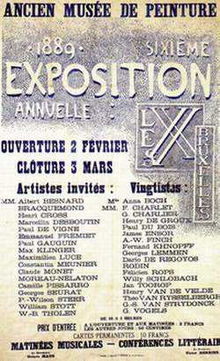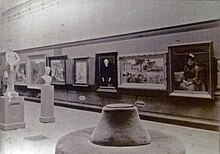Société des Vingt
The Société des Vingt , briefly Les XX or Les Vingt , German Die XX or Die Zwanzig was an association founded on October 28, 1883 by Belgian artists or artists living in Belgium , including Fernand Khnopff , Théo van Rysselberghe , James Ensor , Rodolphe Wytsman and the Siblings Anna and Eugène Boch .
The group did not have a chair. The secretary was the lawyer Octave Maus. His wife Madeleine Octave Maus (1874–1944) helped him and organized the exhibitions. The aim of the 'Vingtists' was to promote new and unconventional art. In addition to concerts and readings, the group held an annual exhibition in Brussels to which the members invited an equal number of other participants. They did not represent any particular aesthetic theory or tendency, but were equally open to all innovative trends.
The merit of the XX is that they recognized the importance of a whole series of trend-setting, later famous artists early on and offered them a forum. Guests at the first exhibition in 1884 included Auguste Rodin , John Singer Sargent and James McNeill Whistler . In 1887, among others, Georges Seurat was invited, as well as Berthe Morisot and Camille Pissarro . During the autumn of 1888, Henri de Toulouse-Lautrec , who had never before taken part in a major exhibition, and Henry van de Velde and Georges Lemmen (1865–1916) were accepted into the group. In 1890 there were six paintings by Vincent van Gogh , whose painting The Red Vineyard found a buyer on this occasion. It is the only documented sale of a picture from the mature creative period during the painter's lifetime.
The exchange initiated by the Société des Vingt contributed to Brussels developing into an important center of modern art in these years .
Despite the invaluable service that the Société des Vingt had rendered to the new Belgian and foreign art movements in painting, sculpture, music and literature, it disbanded after ten years. With the association's assets of 50,000 gold francs , the secretary, art critic and lawyer Octave Maus (1856-1919) opened the annual salon under the new name 'La Libre Esthétique' a year later. Octave Maus chose himself as the sole administrative delegate. The salon had to close in 1914 because of the First World War .
Individual evidence
- ↑ Russell T. Clement, Annick Houzé: Neo-impressionist Painters: A Sourcebook on Georges Seurat, Camille Pissarro, Paul Signac, Théo Van Rysselberghe, Henri Edmond Cross, Charles Angrand, Maximilien Luce, and Albert Dubois-Pillet , Greenwood, London 1999 , ISBN 0-313-30382-7 , p. 270
- ^ Henry van de Velde: 1888 acceptance into the Société des Vingt. Pages 42–44. Retrieved April 17, 2020 .
- ^ Henry van de Velde: 1894 La Libre Esthétique. P. 86. Retrieved April 17, 2020 .
literature
- John Rewald : From van Gogh to Gauguin - The history of post-impressionism , DuMont, Cologne 1987, ISBN 3-7701-2147-3
- Stephen H. Goddard, Jane Block: Les XX and the Belgian avant-garde: prints, drawings, and books , Spencer Museum of Art, 1993, ISBN 978-0913689356
Web links
- Les Vingt near Palais des beaux-arts de Bruxelles (2004)

